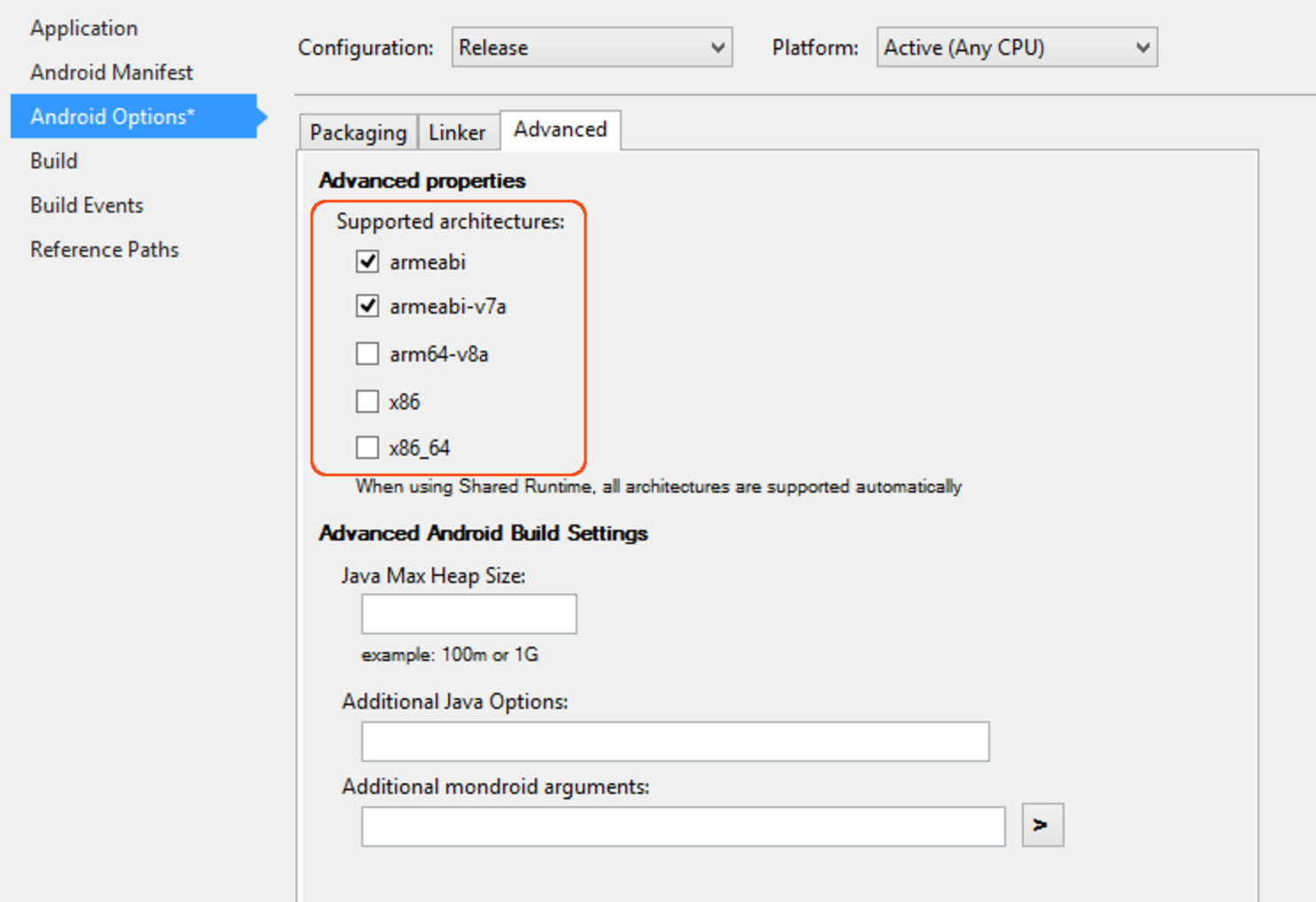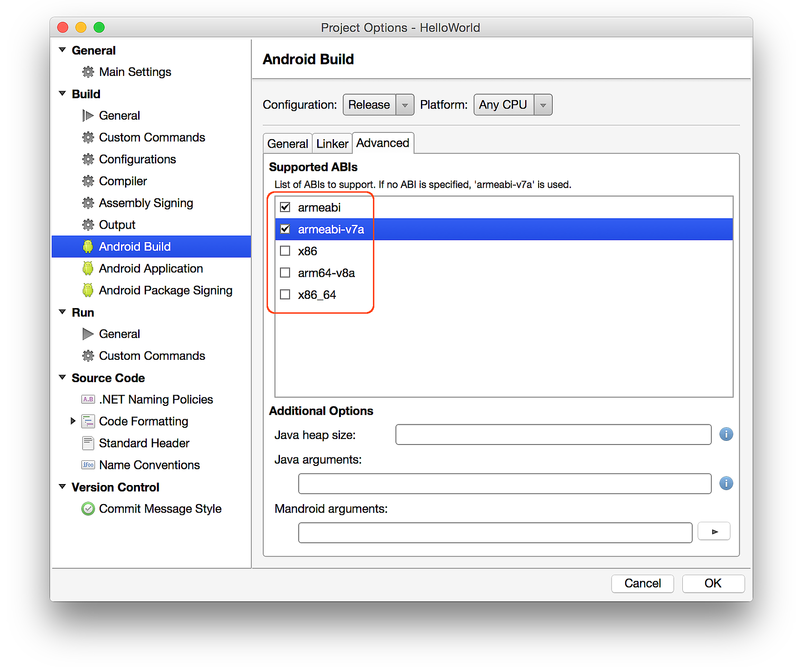Note
Access to this page requires authorization. You can try signing in or changing directories.
Access to this page requires authorization. You can try changing directories.
Android can run on several different computer architectures. This document discusses the different CPU architectures that may be employed for a Xamarin.Android application. This document will also explain how Android applications are packaged to support different CPU architectures. The Application Binary Interface (ABI) will be introduced, and guidance will be provided regarding which ABIs to use in a Xamarin.Android application.
Overview
Android allows for the creation of "fat binaries," a single .apk
file that contains machine code that will support multiple, different
CPU architectures. This is accomplished by associating each piece of
machine code with an Application Binary Interface. The ABI is used to
control which machine code will run on a given hardware device. For
example, for an Android application to run on an x86 device, it is
necessary to include x86 ABI support when compiling the application.
Specifically, each Android application will support at least one embedded-application binary interface (EABI). EABI are conventions specific to embedded software programs. A typical EABI will describe things such as:
The CPU instruction set.
The endianness of memory stores and loads at run time.
The binary format of object files and program libraries, as well as which type of content is allowed or supported in these files and libraries.
The various conventions used to pass data between application code and the system (for example: how registers and/or the stack are used when functions are called, alignment constraints, etc.)
Alignment and size constraints for enum types, structures, fields, and arrays.
The list of function symbols available to your machine code at run time, generally from a very specific selected set of libraries.
armeabi and Thread Safety
The Application Binary Interface will be discussed in detail below, but
it is important to remember that the armeabi runtime used by
Xamarin.Android is not thread safe. If an application that has
armeabi support is deployed to an armeabi-v7a device, many strange
and unexplainable exceptions will occur.
Due to a bug in Android 4.0.0, 4.0.1, 4.0.2, and 4.0.3, the native
libraries will be picked up from the armeabi directory even though
there is an armeabi-v7a directory present and the device is an
armeabi-v7a device.
Note
Xamarin.Android will ensure that .so are added to the APK in the correct order. This bug should not be an issue for users of Xamarin.Android.
ABI Descriptions
Each ABI supported by Android is identified by a unique name.
armeabi
This is the name of an EABI for ARM-based CPUs that support at least
the ARMv5TE instruction set. Android follows the little-endian ARM
GNU/Linux ABI. This ABI does not support hardware-assisted
floating-point computations. All FP operations are performed by
software helper functions that come from the compiler's libgcc.a
static library. SMP devices are not supported by armeabi.
Important
Xamarin.Android's armeabi code is not thread safe and
should not be used on multi-CPU armeabi-v7a devices (described
below). Using armeabi code on a single-core armeabi-v7a device is
safe.
armeabi-v7a
This is another ARM-based CPU instruction set that extends the
armeabi EABI described above. The armeabi-v7a EABI has support for
hardware floating-point operations and multiple CPU (SMP) devices. An
application that uses the armeabi-v7a EABI can expect substantial
performance improvements over an application that uses armeabi.
Note
armeabi-v7a machine code will not run on ARMv5 devices.
arm64-v8a
This is a 64-bit instruction set that is based on the ARMv8 CPU architecture. This architecture is used in the Nexus 9. Xamarin.Android 5.1 introduced support for this architecture (for more information, see 64-bit runtime support).
x86
This is the name of an ABI for CPUs that support the instruction set commonly named x86 or IA-32. This ABI corresponds to instructions for the Pentium Pro instruction set, including the MMX, SSE, SSE2, and SSE3 instruction sets. It does not include any other optional IA-32 instruction set extensions such as:
- the MOVBE instruction.
- Supplemental SSE3 extension (SSSE3).
- any variant of SSE4.
Note
Google TV, although it runs on x86, is not supported by Android's NDK.
x86_64
This is the name of an ABI for CPUs that support the 64-bit x86 instruction set (also referred to as x64 or AMD64). Xamarin.Android 5.1 introduced support for this architecture (for more information, see 64-bit runtime support).
APK File Format
The Android Application Package is the file format that holds all of
the code, assets, resources, and certificates necessary for an Android
application. It is a .zip file, but uses the .apk file name
extension. When expanded, the contents of an .apk created by
Xamarin.Android can be seen in the screenshot below:
A quick description of the contents of the .apk file:
AndroidManifest.xml – This is the
AndroidManifest.xmlfile, in binary XML format.classes.dex – This contains the application code, compiled into the
dexfile format that is used by the Android runtime VM.resources.arsc – This file contains all of the precompiled resources for the application.
lib – This directory holds the compiled code for each ABI. It will contain one subfolder for each ABI that was described in the previous section. In the screenshot above, the
.apkin question has native libraries for botharmeabi-v7aand forx86.META-INF – This directory (if present) is used to store signing information, package, and extension configuration data.
res – This directory holds the resources that were not compiled into
resources.arsc.
Note
The file libmonodroid.so is the native library required by all Xamarin.Android applications.
Android Device ABI Support
Each Android device supports executing native code in up to two ABIs:
The "primary" ABI – This corresponds to the machine code used in the system image.
A "secondary" ABI – This is an optional ABI that is also supported by the system image.
For example, a typical ARMv5TE device will only have a primary ABI of
armeabi, while an ARMv7 device would specify a primary ABI of
armeabi-v7a and a secondary ABI of armeabi. A typical x86 device
would only specify a primary ABI of x86.
Android Native Library Installation
At package installation time, native libraries within the .apk are
extracted into the app's native library directory, typically
/data/data/<package-name>/lib, and are thereafter referred to as
$APP/lib.
Android's native library installation behavior varies dramatically between Android versions.
Installing Native Libraries: Pre-Android 4.0
Android prior to 4.0 Ice Cream Sandwich will only extract native libraries
from a single ABI within the .apk. Android apps of this
vintage will first try to extract all native libraries for the primary ABI, and
if no such libraries exist, Android will then extract all native libraries for
the secondary ABI. No "merging" is done.
For example, consider a situation where an application is installed on
an armeabi-v7a device. The .apk, which supports both armeabi and
armeabi-v7a, has the following ABI lib directories and files in it:
lib/armeabi/libone.so
lib/armeabi/libtwo.so
lib/armeabi-v7a/libtwo.so
After installation, the native library directory will contain:
$APP/lib/libtwo.so # from the armeabi-v7a directory in the apk
In other words, no libone.so is installed. This will cause
problems, as libone.so is not present for the application to load
at run time. This behavior, while unexpected, has been logged as a bug and
reclassified as "working as intended."
Consequently, when targeting Android versions prior to 4.0, it is necessary
to provide all native libraries for each ABI that the
application will support, that is, the .apk should contain:
lib/armeabi/libone.so
lib/armeabi/libtwo.so
lib/armeabi-v7a/libone.so
lib/armeabi-v7a/libtwo.so
Installing Native Libraries: Android 4.0 – Android 4.0.3
Android 4.0 Ice Cream Sandwich changes the extraction logic. It will enumerate all native libraries, see if the file's basename has already been extracted, and if both of the following conditions are met, then the library will be extracted:
It hasn't already been extracted.
The native library's ABI matches the target's primary or secondary ABI.
Meeting these conditions allows "merging" behavior; that is, if we have
an .apk with the following contents:
lib/armeabi/libone.so
lib/armeabi/libtwo.so
lib/armeabi-v7a/libtwo.so
Then after installation, the native library directory will contain:
$APP/lib/libone.so
$APP/lib/libtwo.so
Unfortunately, this behavior is order dependent, as described in the following document - Issue 24321: Galaxy Nexus 4.0.2 uses armeabi native code when both armeabi and armeabi-v7a is included in apk.
The native libraries are processed "in order" (as listed by, for
example, unzip), and the first match is extracted. Since the .apk
contains armeabi and armeabi-v7a versions of libtwo.so, and the
armeabi is listed first, it's the armeabi version that is
extracted, not the armeabi-v7a version:
$APP/lib/libone.so # armeabi
$APP/lib/libtwo.so # armeabi, NOT armeabi-v7a!
Furthermore, even if both armeabi and armeabi-v7a ABIs are
specified (as described below in the section Declaring Supported
ABIs), Xamarin.Android will create the following element in the .
csproj:
<AndroidSupportedAbis>armeabi,armeabi-v7a</AndroidSupportedAbis>
Consequently, the armeabi libmonodroid.so will be found first
within the .apk, and the armeabi libmonodroid.so will be the one
that is extracted, even though the armeabi-v7a libmonodroid.so is
present and optimized for the target. This can also result in obscure
run-time errors, as armeabi is not SMP safe.
Installing Native Libraries: Android 4.0.4 and later
Android 4.0.4 changes the extraction logic: it will enumerate all native
libraries, read the file's basename, then extract the primary ABI version (if
present), or the secondary ABI (if present). This allows "merging" behavior;
that is, if we have an .apk with the following contents:
lib/armeabi/libone.so
lib/armeabi/libtwo.so
lib/armeabi-v7a/libtwo.so
Then after installation, the native library directory will contain:
$APP/lib/libone.so # from armeabi
$APP/lib/libtwo.so # from armeabi-v7a
Xamarin.Android and ABIs
Xamarin.Android supports the following 64-bit architectures:
arm64-v8ax86_64
Note
From August 2018 new apps will be required to target API level 26, and from August 2019 apps will be required to provide 64-bit versions in addition to the 32-bit version.
Xamarin.Android supports these 32-bit architectures:
armeabi^armeabi-v7ax86
Note
^ As of Xamarin.Android 9.2, armeabi is no longer supported.
Xamarin.Android does not currently provide support for mips.
Declaring Supported ABI's
By default, Xamarin.Android will default to armeabi-v7a for
Release builds, and to armeabi-v7a and x86 for Debug
builds. Support for different ABIs can be set through the Project
Options for a Xamarin.Android project. In Visual Studio, this can be
set in the Android Options page of project Properties, under
the Advanced tab, as shown in the following screenshot:

In Visual Studio for Mac, the supported architectures may be selected on the Android Build page of Project Options, under the Advanced tab, as shown in the following screenshot:
There are some situations when it may be necessary to declare additional ABI support such as when:
Deploying the application to an
x86device.Deploying the application to an
armeabi-v7adevice to ensure thread safety.
Summary
This document discussed the different CPU architectures that an Android
application may run on. It introduced the Application Binary Interface
and how it is used by Android to support disparate CPU architectures.
It then went on to discuss how to specify ABI support in a
Xamarin.Android application and highlighted the issues that arise
when using Xamarin.Android applications on an armeabi-v7a device that
are intended only for armeabi.

